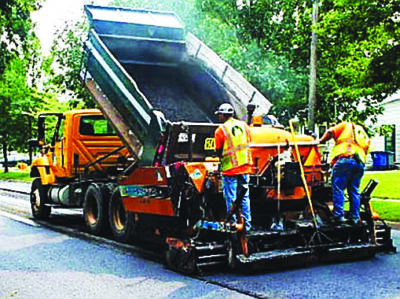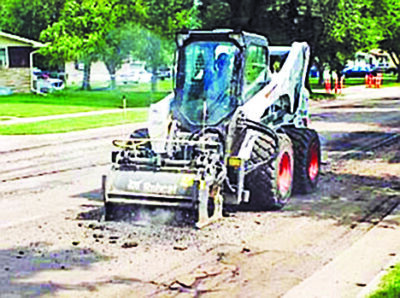- Bob Zimmerman City Engineer
- Mill and overlay projects grind down the top 2 inches of asphalt and reapply it, returning the street’s condition to near-100%. (Photos/Engineering Department.)
- Routine maintenance is focused on extending the useful life of the city’s streets before full reconstruction is required.
Worst streets no longer come first
Nancy Edmonds Hanson
When it comes to maintaining city streets, there’s no pleasing everyone. Some Moorheaders grimace and growl when their cars bottom out on pesky potholes. Other residents – sometimes the very same – get irate when that same avenue fronting their abode is scheduled for reconstruction … pleased by the city’s attention to their bumps and jostles, but mightily alarmed by the special assessments needed to pay the price.
And then there’s the cost of these repairs. The bumpier the pavement, the bigger budgetary bite.
“We used to fix the worst, first,” city engineer Bob Zimmerman concedes. “That meant that every street we worked on needed the most expensive option – complete reconstruction.” That means the entire section of pavement must be replaced, including whatever is beneath it, along with new curbs, gutters and sidewalks and possible underground work on sewers and water mains. “That meant that every job required the maximum amount of investment and work.”
For at least the past five years, the engineering department has followed a different path. Instead of waiting for the city’s 201 miles of streets to hit bottom, they have adopted a pavement management program that prioritizes repairing roadways as they begin to deteriorate. The practice weighs the street’s condition, its pavement type and composition, the potential need for utility work and the funding that’s available.
You could sum the practice up with the motherly admonition that “a stitch in time saves nine.” By repairing lesser problems as they develop – using less expensive techniques – the streets’ life can be greatly extended. And it costs much less.
“In a way, it’s counter-intuitive,” Zimmerman concedes. “Why fix minor problems instead of chasing the biggest?
“But you can compare it to operating a car,” he continues. “When you drive that new car off the lot, it doesn’t need maintenance. But if you never spend a cent on keeping it up, eventually it’s going to fall apart. On the other hand, if you keep up with routine maintenance as you go along, you’ll make a series of smaller investments … but that car is going to continue running well much, much longer. Small investments make the better sense in the long run.”
Judging the state of the streets is no longer a matter of eyeballing them. The engineer describes the cycle in which a contractor is engaged to study every mile’s condition once every three years. Streets’ status is assessed on a scale from 100% (perfect condition) to 0% (perfectly awful).
Then the department plans its approach. “The goal of pavement management is to ensure the right strategy is applied at the right time for roads to remain safe and durable,” Zimmerman says, quoting from the city’s new pavement management website. That generally means taking steps, from mild to major, to keep moisture from infiltrating below the asphalt or concrete surface of the road. “The freeze0thaw cycle is one of our biggest problems,” he notes. “When water gets under the pavement, it ruins it.”
Minor maintenance: If only spot repairs are needed to keep water out, patching may be called for. A seal coat can be applies by covering the surface with oil and then spreading pea rock that will be compacted by traffic. Crack sealing is an alternative, with an asphalt and oil mixture filling the openings to stop the seepage.
Mill and overlay: Approximately 2 inches of the surface will be ground down for removal and replacement. Intact curbs and gutters are left alone, though damaged areas might be replaced. Pavement will be patched where needed.
Rehab: Now the entire pavement section will be removed, along with the material beneath it. Again, curbs, gutters and sidewalks will be improved only as needed.
Reconstruction: This means big-time work and investment. A contractor will remove the full pavement section and underlying material. Curbs and gutters are completed gutted and replaced. The cost in both money and time is substantial, causing the greatest amount of inconvenience for surrounding homeowners.
When the budget needs stretching, the engineers prioritize arterial and collector streets over quieter residential roadways. The city maintains 56 miles in those categories, including the heaviest-traveled streets and those that connect them to neighborhoods. Local (residential) streets stretch for 145 miles. Though their mileage is almost three times greater than the main roads, neighborhood roadways carry only 20% of the traffic that rolls along the majors every day.
“We want to target the types of projects where we can achieve the highest long-term average condition at the lowest cost,” he summarizes. “Streets that are already in the poorest condition will be allowed to continue to deteriorate to the minimum tolerable level. At that point in its life cycle, reconstruction makes the most sense, both financially and to extend its useful life.
“We want to catch streets at the right time, when we have that window of opportunity. Then we can return them to 100%, or nearly that, to extend their useful life all over again.”
Inevitably, Zimmerman admits, residents will always have questions about why their own street is, or is not, being repaired. His department has developed a detailed website that explains in detail how street condition is assessed and improvement projects scheduled. The site includes clickable maps that identify areas due for maintenance, offering details about each scheduled project. To find it, google “Moorhead Roads A Solid Investment.”





